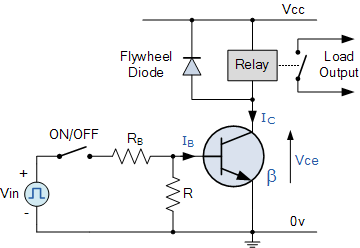Transistors are one of the most important inventions of the 20th century. Because of the transistors, we are able to build much faster, much smaller, and very energy-efficient controller circuits at a very low cost.
Your computer or mobile phone consists of microprocessors and ICs, which contain billions of transistors.
The Transistor is a three terminal solid state device that can do two different jobs. It can work either as an amplifier or a switch:
There are two types of basic transistor out there: bi-polar junction (BJT) and metal-oxide field-effect (MOSFET). In this tutorial we'll focus on the BJT, because it's slightly easier to understand.
The bi-polar junction transistors (BJT), are divided into two groups, NPN and PNP.
The circuit symbols for both the NPN and PNP BJT are like this.
The pins are labeled collector C, base B, and emitter E.
The only difference between the symbols of NPN and PNP is the direction of the arrow on the emitter. The arrow on an NPN points out, and on the PNP it points in.
In NPN transistors One P-type semiconductor layer is sandwiched between the two N-type semiconductor layers. The current flows from collector terminal to emitter terminal.
In PNP transistors One N-type semiconductor layer is sandwiched between the two P-type semiconductor layers. The current flows from the emitter to the collector terminal.
Both symbols, the arrow head indicate the current flowing direction.
In NPN transistors The current flows from collector terminal to emitter terminal.
In PNP transistors The current flows from emitter to collector terminal.
Transistors are one of the most important inventions of the 20th century. Because of the transistors, we are able to build much faster, much smaller, and very energy-efficient controller circuits at a very low cost.
Your computer or mobile phone consists of microprocessors and ICs, which contain billions of transistors.
The Transistor is a three terminal solid state device that can do two different jobs. It can work either as an amplifier or a switch:
There are two types of basic transistor out there: bi-polar junction (BJT) and metal-oxide field-effect (MOSFET). In this tutorial we'll focus on the BJT, because it's slightly easier to understand.
The bi-polar junction transistors (BJT), are divided into two groups, NPN and PNP.
The circuit symbols for both the NPN and PNP BJT are like this.
The pins are labeled collector C, base B, and emitter E.
The only difference between the symbols of NPN and PNP is the direction of the arrow on the emitter. The arrow on an NPN points out, and on the PNP it points in.
In NPN transistors One P-type semiconductor layer is sandwiched between the two N-type semiconductor layers. The current flows from collector terminal to emitter terminal.
In PNP transistors One N-type semiconductor layer is sandwiched between the two P-type semiconductor layers. The current flows from the emitter to the collector terminal.
Both symbols, the arrow head indicate the current flowing direction.
In NPN transistors The current flows from collector terminal to emitter terminal.
In PNP transistors The current flows from emitter to collector terminal.
























No comments:
Post a Comment